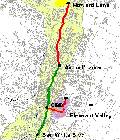
Light Rail Now and Walkable Neighborhoods (LRN) can be contacted at: Light Rail Now! |
Austin: Public Meetings Consider Routes, Costs Special Report by Light Rail Progress Capital Metro recently held a series of information Sharing Meetings, focused on the recently presented route and cost options for the proposed light rail transit (LRT)/Bus Rapid Transit (BRT) system. During these meetings, which took place 21 August through 29 August 2000, Metro personnel and consultants presented the technical analysis completed to date and got feedback from the community on perceptions on different options through the corridor. While question-and-answer exchanges took place during the meetings, Metro personnel managed to keep the discussion focused on the specific issues on the table. All this information has been forwarded the Board as a resource for their expression of preference, in a board meeting scheduled for September 18. A number of LRT supporters attended these meetings and provided input on these route and cost issues. Light Rail Progress continues to urge LRT proponents to support a basic route plan which optimizes engineering, cost, and ridership for the initial startup system (see figure above). This route plan includes: • Surface alignments throughout, rather than any of the
elevated (or subsurface) options. Cost must be minimized to facilitate eventual extension of
the system, promoting access and connectivity. • A surface LRT alignment from Howard Lane to N. Lamar which stays on the railroad right-of-way (ROW). This is by far the lowest-cost, most direct, and fastest route
for this portion of the corridor. it has the greatest ridership
potential at the least cost. Minimizing installation cost will
free money for further and faster expansion of the LRT
system. • A direct surface route from the railroad ROW onto Lamar and south. • The preferred route (6E) through the UT/core area to downtown, using a double-track installation on Guadalupe to Cesar Chavez (formerly W. 1st). This is by far the least-cost option for this comparatively
expensive portion of the system. it is reasonably close to
Congress and the downtown center. it is direct and mostly
straight, solves a number of engineering problems, and
avoids the problem of service interruptions during parades
on Congress. The Guadalupe route would also serve the
new high-tech complex being installed in that part of lower
downtown. • First Street (Drake) Bridge to South Austin. • Riverside to S. Congress, and south. This would serve important development in this area and provide a connection to S. Congress with relatively minimal engineering and operational problems. The S. Congress route, using the existing very wide avenue, would be ideal for relatively fast, street-routed LRT in a segregated reservation. • East Austin rail ROW alignment (9B) to Martin Luther King (formerly E. 9th St.). While this option adds about $34 million to the system cost,
this is a 1.3-mile extension rather than a more expensive
type of construction. The extension is desired by many East
Austin residents, and it would facilitate access to jobs and
other activities by a section of the population with higher
average unemployment and greater dependency on transit. Additional information on proposed routes, costs, etc. is also posted on the Capital Metro website: http://www.capmetro.org/index.html Light Rail Progress – Rev. 00/08/30 Support light rail for Austin! |
|
|
|